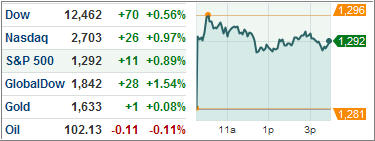Despite continuing concerns surrounding Europe, the S&P 500 rose 0.89% while European and Asian indices also posted large gains. Meanwhile, the 10-year Treasury yield went up as did commodity prices.
However, the Euro moved very little against the dollar, sticking to $1.28/Euro. The trend of record high deposits at the ECB despite new liquidity measures highlights the frailty of the financial system, which can’t be ignored.
Yesterday, I mentioned that it might be an appropriate time to gain some equity exposure especially with minimized volatility. Given some of the upward momentum, as the S&P 500 is above its long-term moving average, taking on equity ETFs very selectively can reap some benefits. Yet, the level of uncertainty that exists in markets serves a reminder that a big drop can happen at any time.
After Germany issued negative interest rates for its debt, the UK has now followed suit. Alarmingly, the UK issued 35-year bonds at a rate of -0.12%. The system is surely broken when investors are willing to pay a fee to preserve their capital. If this apparent flight to safety isn’t a danger sign, then I don’t know what is.
Bad news bears continue for the PIIGS. Italy’s 10-year bond has now climbed to 7.17%, making Italy’s debt load increasingly unsustainable. And amid talks of economic stagnation due to austerity measures, Portugal announced it expected a GDP contraction over 3%.
Ireland is also in a tight spot after comments from Citi’s chief economist that the country may have to restructure its bailout deal and possibly Greek style bond haircuts. Having a deficit that is over 31% of GDP (see data summary in this link), the worst in Europe, surely doesn’t help.
In Eastern Europe, Hungary is facing a tipping point hinging on whether or not it will get a sufficient IMF loan. The future looks bleak when 3-month bonds are going for 7.98%. With this plethora of negativity, it boggles my mind how markets can go up.
Amidst the tense housing situation in the U.S., the Fannie Mae CEO stepped down. Hopefully a change in leadership can bring some much needed help to the ailing residential market that has left the economy in a lull.
Interestingly, this past November represented the biggest increase in consumer borrowing in 10 years. I’m skeptical this means there will be a steady rise in consumption though. Hopefully Americans aren’t going back to their generally non-saving tendencies as evidenced before the crisis.
While it’s difficult to deny that January has started off pretty well, all the news is indicating otherwise. Regardless, I am still bracing for a rude awakening through a limited risk ETF strategy.
Contact Ulli

Comments 5
At this point in time, what selective equity/bond ETF’s would you suggest retirees consider for a taxable account?
Dennis,
It depends on an individual’s circumstances along with their risk tolerance. I can’t make broad based recommendations without having a client relationship. I provide you with the back up data, but you need to make the decisions for yourself.
Ulli…
That seems a very good summary of the current European crisis. I defifitely appreciate that you’re sharing this information as well as the basic, cautious moves we might wat to make at this time.
Thanks,
Ron Bailey
I refrained from new positions after the dom. buy signal was issued late last year.
I’ve since adjusted my outlook and yesterday I took a position in XLP. It is high on the HV cut list yet far enough down to fit my comfort level right now. Further, I only placed a small % of total investable money at risk.
Should volatility remain low I may also invest in DVY in the next few days/weeks.
GH,
That thinking goes along with mine…
Ulli…